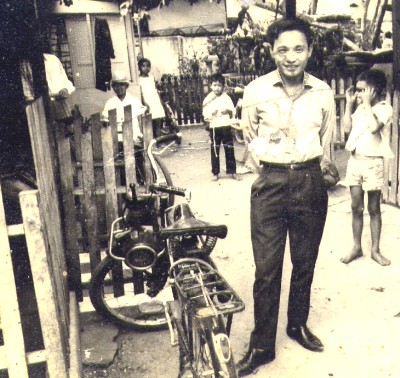Shanghai: The Vigor in the Decay
Ian Johnson
Note: Đọc bài
này, nhìn hình, là Gấu bèn nhớ tới những ngày ở Sài Gòn, thời mới lớn,
những hẻm Đội Có, Nguyễn Huỳnh Đức, Xóm Mả Đỏ, Xóm Gà, Ngã Ba Chú
Ía… , và cái tham vọng viết về
chúng, về Vigor in the Decay [Cường tráng trong Lụi tàn].
"Phép Lạ Kinh Tế" của lũ VC làm mất sạch
"Phép Lạ Kinh Tế" của lũ VC làm mất sạch

Gấu, căn nhà ở hẻm Nguyễn Huỳnh Đức Phú Nhuận, chiếc solex ngày nào, và...
Tất cả xẩy
ra ở Thượng Hải – và trên chục thành phố dọc theo TQ, và thế giới –
nhưng điều mà
Howwad French và Qiu Xiaolong thực hiện
trong "Thượng Hải Biến Mất", một cuốn sách không bình thường, với những
hình ảnh
& thơ & tiểu luận về một "Cách Ở Đời Tư Riêng". Không có thứ
hình ảnh bản
kẽm, về 1 người hành khất, trước 1 cái xách tay Louis Vuilton trên mặt
tường,
hay những người công nhân, nhìn không hiểu được, 1 chiếc
Bentley chạy vô 1 khách sạn 5 sao, hay bất cứ 1 nơi nào sang trọng.
Thay vì vậy, chúng ta được đẩy sâu vô những cuộc đời của những con người bình thường, vào những căn phòng khách nhỏ nhắn của họ, tường mốc meo, những bức rèm bạc phếch. Chúng ta nhìn thấy họ sống trong những phố, những hẻm, hè đường, mặt nhà thì cũng rệu rạo như những cuộc đời của họ. Chúng ta nhìn ngắm họ hưởng nhàn, xả hơi, nhâm nhi ly cà phê…
Cái tạm bợ, cái điêu tàn, suy sụp cho thấy, đây là 1 thế giới đang biến mất.
Thay vì vậy, chúng ta được đẩy sâu vô những cuộc đời của những con người bình thường, vào những căn phòng khách nhỏ nhắn của họ, tường mốc meo, những bức rèm bạc phếch. Chúng ta nhìn thấy họ sống trong những phố, những hẻm, hè đường, mặt nhà thì cũng rệu rạo như những cuộc đời của họ. Chúng ta nhìn ngắm họ hưởng nhàn, xả hơi, nhâm nhi ly cà phê…
Cái tạm bợ, cái điêu tàn, suy sụp cho thấy, đây là 1 thế giới đang biến mất.
Shanghai: The Vigor in the Decay

All of this is happening in Shanghai—and dozens of cities across China and around the world—but it’s not how Howard French and Qiu Xiaolong tell it in their unusual new book of photographs, poems, and essays, Disappearing Shanghai: Photographs and Poems of an Intimate Way of Life. We get no clichéd pictures of a beggar in front of a Louis Vuitton mural, no workers looking uncomprehendingly at a Bentley pulling into a five-star whatever. Instead we are thrust deeply into ordinary people’s lives, into their tiny living rooms with moldy walls and faded curtains. We see them living out on streets of cracked sidewalks and crumbling facades. We watch them sitting and waiting in poses of leisure. The transience and decay tells us that all this is vanishing.

The pictures are mostly portraits of people, some staring at the photographer, others caught in the middle of a laugh or conversation. One shows a woman selling paper money, which mourners burn at graves on certain holidays. The blurred stacks of otherworldly bills rise out in front of her like Shanghai’s new luxury towers, while she glances up, her face uncertain of where she is.

perhaps richer than numerous bankersIn another we are thrust into an elderly woman’s living room, where she sits motionless and expressionless next to a window, a giant character for “happiness” hanging from the ceiling.
in the world, and all in cash,
for the underworld, shadows
and memories lurking around.

with pots, bottles, medicines, ashtraysAll the photos are black and white, emphasizing the grainy but sharp life of Shanghai’s backstreets. In one photo a young boy is sitting on a curb, looking like an old man, every flake of the rotting façade behind him in focus.
(so he will never go hungry,
thirsty, nicotine-craving, or sick),
and an old-fashioned clock ticking
still like his heartbeat…

French also takes us to a room shared by several migrant women caught laughing over a joke or a lover. In the accompanying text, Qiu imagines that inspector Chen has just interviewed them about the murder of one of their friends. The little story reminds us that many of the people left living in the old city are not Shanghainese but poor migrants willing to put up with the cramped conditions. And yet they also remind us of the city’s vigor: the women laugh; they are here to make money and participate in the boom and their aspirations are captured in the fake wedding picture hanging on the wall above them.

Disappearing Shanghai: Photographs and Poems of an Intimate Way of Life, photographs by Howard W. French and poems by Qiu Xiaolong

Comments
Post a Comment